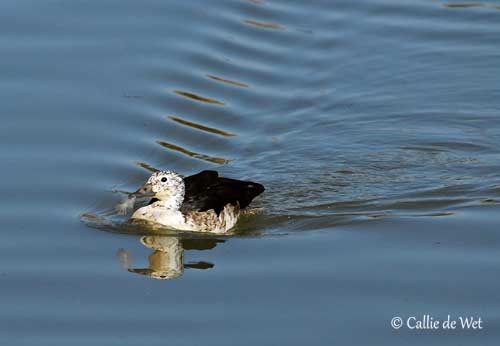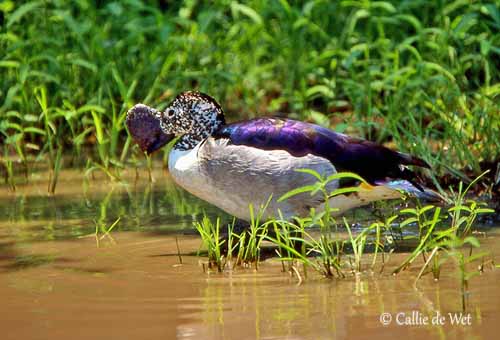
Fr: Canard ou Sarcidiorne à bosse
All : Glanzente
Esp: Pato crestudo
Ital : Anatra bernoccoluta
Nd: Knobbeleend
Sd: Knöland
Port: Pato-de-crista
Photographers:
Callie de Wet
GALLERY
Nicole Bouglouan
PHOTOGRAPHIC RAMBLE
Text by Nicole Bouglouan
Sources:
HANDBOOK OF THE BIRDS OF THE WORLD vol 1 by Josep del Hoyo-Andrew Elliot-Jordi Sargatal - Lynx Edicions - ISBN: 8487334105
A Field Guide to the Birds of South-East Asia by Craig Robson. New Holland Publishers. ISBN: 9781780090498
ROBERTS BIRDS OF SOUTH AFRICA by G. R. Mc Lachlan and R. Liversidge – The Trustees of the John Voelcker Bird Book Fuund – ISBN: 0620031182
GUIDE DES CANARDS, DES OIES ET DES CYGNES – de Steve Madge - Delachaux et Niestlé - ISBN: 2603013769
BirdLife International (BirdLife International)
Wikipedia, the free encyclopaedia
Knob-billed Duck
Sarkidiornis melanotos
Anseriforme Order – Anatidae family
BIOMETRICS:
Length: 56-76 cm
Weight: 1250-2600 g
DESCRIPTION:
The Knob-billed Duck has distinctive appearance with the fleshy knob of the male. This species has wide range, shared by two subspecies, but the race “sylvicola” is now considered as full species under the name Comb Duck.
The adult male of the nominate race has blackish upperparts, wing-coverts and secondary flight feathers with green, bluish-purple and bronze gloss. The rump is grey.
The underparts are white, except the greyish flanks and some narrow black bars on breast sides. The undertail-coverts are white, often tinged yellow.
Head and neck are white with black speckles. Crown and nape appear almost black, due to concentration of black spots.
It has prominent, fleshy, blackish knob at base of the upper mandible. The bill is black. The eyes are dark brown. Legs and webbed feet are blackish.
In breeding plumage, the knob is much larger, and the sides of head and neck are washed yellowish-buff.

The female is similar but smaller and duller than male, and she lacks the fleshy knob. Her plumage is less glossy.
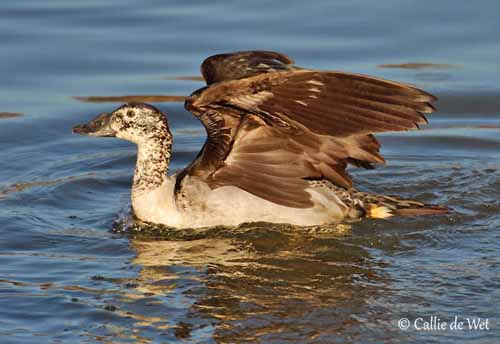
The juvenile is brownish with dark brown crown and upperparts, and scaled underparts.
We can find two subspecies:
S.m. melanotos (here described and displayed) from Africa south of the Sahara and Madagascar, and tropical Asia from Pakistan, through Indian subcontinent to extreme S China.
S.m. sylvicola is now considered full species. It is found in tropical South America, from Colombia to N Argentina.
This one has similar plumage except the black flanks.
VOICE: SOUNDS BY XENO-CANTO
The Knob-billed Duck is usually silent but it may occasionally utter some low croaking sounds. During the breeding period, it gives whistles and grunts during the displays or when fighting against rivals. The female gives quacks and grunts.
A hoarse, whistled sound can be heard during the flight.
HABITAT:
The Knob-billed Duck frequents wet areas such as swamps, rivers and lakes with scattered trees. It may occur in more open lowlands and grasslands in tropical regions.
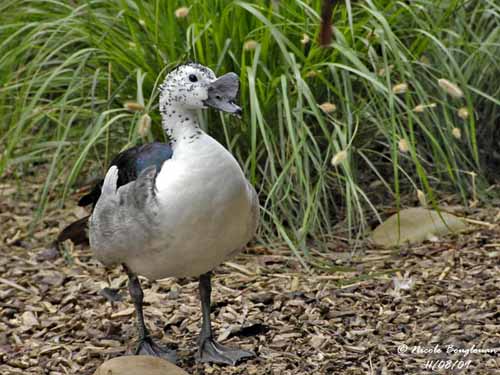
RANGE:
See above in “subspecies”.
BEHAVIOUR:
The Knob-billed Duck may cling into trees thanks to its strong claws. It occurs singly or in pairs, and also in small groups of 30-40, often with other duck species. It feeds both on land and in water. On land, it grazes and takes terrestrial insects. In shallow water, it swims, dabbles and wades, feeding on plant matter such as seeds of grasses, sedges and aquatic plants. It also catches aquatic invertebrates.
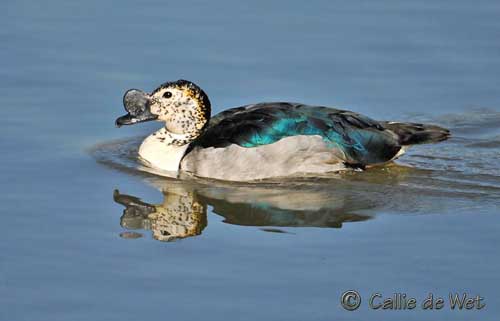
During the dry season, they gather in larger flocks at permanent waters. Later, the pairs form at the beginning of the rainy season.
Outside the breeding season, the Knob-billed Duck is fairly gregarious. But during the nesting period, it is territorial but not very strongly.
The dominant males may copulate with two or more females. These ducks can breed in loose colonies. The male usually defends its family but not the nest-site.
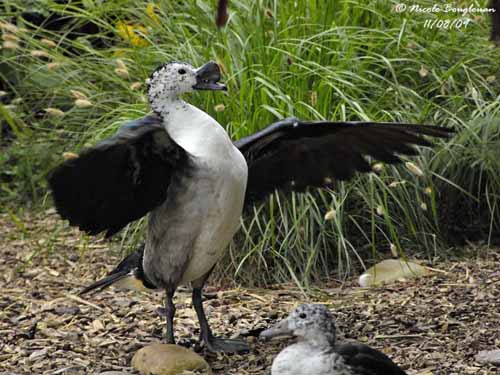
The solitary males often perch in trees from where they watch the flocks, and they swoop down to mate with a female.
The Knob-billed Duck is mainly sedentary in its range. Seasonal movements and dispersions occur, according to the water availability.
FLIGHT:
The Knob-billed Duck is a good flier. It performs slow, but steady and noisy wingbeats.
When they move to find water, they fly in irregular formation, or in single-file lines, or in V-formation.
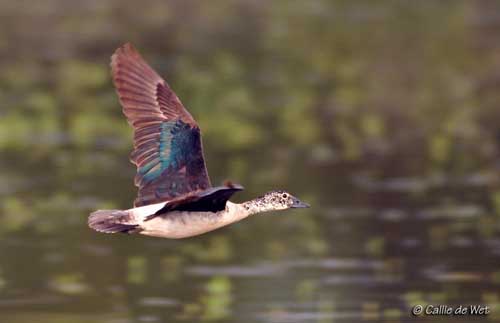
REPRODUCTION:
The breeding season usually occurs during and after the rainy season.
The Knob-billed Duck often breeds in holes in dead trees, between 6 and 9 metres above the ground and sometimes, relatively far from water. They also nest occasionally on the ground in tall grass or amongst stones near water, or in cavity in bank or wall. Usually, the same nest-site is used year after year.
The nest is a rough structure made with sticks and coarse grass. It is lined with softer materials such as grass, reeds, leaves and feathers, but no down.
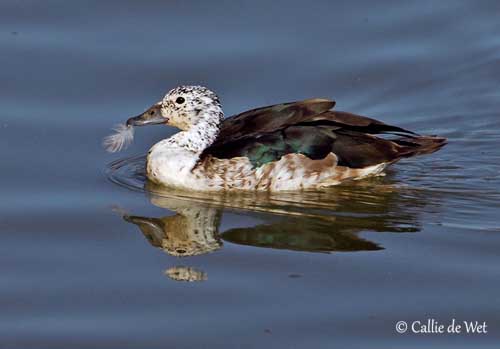
The female lays 7-15 yellowish-white eggs, and incubates during about 28-30 days. At hatching, the chicks have greyish-brown down above and yellowish face and underparts. They are precocial and the family is often seen in small group after hatching. The young fledge about ten weeks later.
They may perform “dump-nesting” with a communal nest for several females. The clutch may contain up to 50 eggs.
The male defends the female and may be aggressive against intruders if the young are threatened.
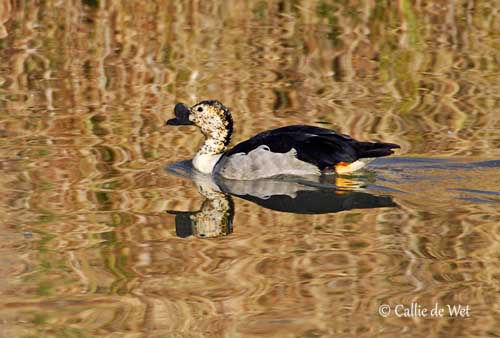
DIET:
The Knob-billed Duck feeds on aquatic plants and invertebrates when wading in shallow water. It also takes small fish.
On land, it grazes and takes terrestrial insects.
This duck spends most of its time resting on bank or islet during the day, and feeds mainly in the early morning and the late evening.
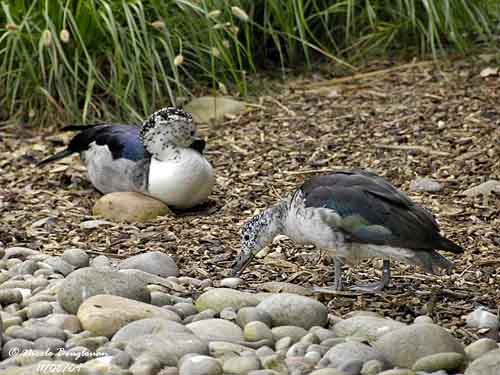
PROTECTION / THREATS / STATUS:
The Knob-billed Duck is still widely distributed, and has large population in Africa. But this species is probably declining in Asia;
The race “sylvicola” is evaluated as “near threatened”.
Both races are threatened by deforestation, use of poison in ricefields in S America where it is considered a pest, and overhunting in Madagascar.
However, this species is not currently globally threatened.
